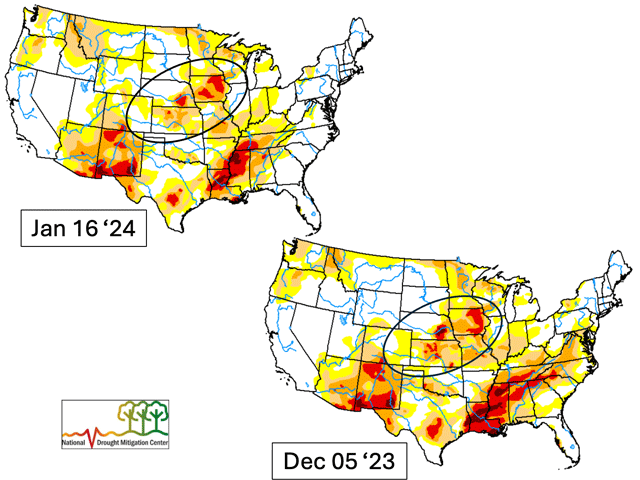Ag Weather Forum
Dry Western Corn Belt Sees Limited Benefit from El Nino Winter Precipitation
The end of December through the first half of January saw El Nino-related winter conditions envelop much of the contiguous U.S. with rain and snow along with bone-rattling Arctic cold. But so far, the precipitation has not made much of a difference in dryness across some high production areas of the Western Corn Belt; dryness which began after the end of the last El Nino event in 2019.
A comparison of the U.S. Drought Monitor for Jan. 16, 2024 and Dec. 5, 2023 shows that Kansas and northern Missouri saw some notable drought easing; in fact, parts of northern Missouri are drought-free as of the middle of January. However, Iowa and eastern Nebraska, along with southern Minnesota and southwestern Wisconsin, have had substantially less of a change in drought. (East-central Nebraska has had a removal of exceptional drought but is still in extreme drought.)
P[L1] D[0x0] M[300x250] OOP[F] ADUNIT[] T[]
Iowa, which has some of the driest conditions during the past four years, has minimal drought easing so far this winter. Drought still covers more than 96% of the state, only 3% less than in early December according to the Drought Monitor. In that six-week time frame, the percentage of Iowa with severe drought or worse has actually increased; from just over 62% in early December to just over 63% in mid-January.
"In eastern Iowa, the continued deep profile dryness is due to the longer-term precipitation deficits going back a year or more," said Iowa State Climatologist Justin Glisan in an email to DTN. "The snowpack we've accumulated will insulate the profile and prevent a deeper frost level, so hopefully we'll get a good thaw and infiltration; (there are) 2 to 4 inches of snow-water equivalent in the snowpack."
Seasonal drought forecasts point to continued easing of drought in Kansas and Missouri along with drought becoming less intense in eastern Nebraska and western Iowa. Central and eastern Iowa, however, are still indicated to be in drought through at least the first one-third of this calendar year (through April 30, 2024). That's how extensive dryness is, even with a heavy dose of snow in the past 10 days; soil moisture is not likely to have penetrated into the root zone for crop supplies later this spring. "We have some incredibly dry soils in parts of Iowa," said USDA Midwest Climate Hub director Dennis Todey. "We could have put 1 to 2 inches on and really not moistened the soil to much depth."
Drought caused an estimated $14.5 billion in damage during 2023 and led the list of billion-dollar weather and climate disasters in the U.S. in 2023. A record 28 billion-dollar weather and climate disasters occurred last year with a total estimated damage of $92.9 billion. (See https://www.dtnpf.com/…)
DTN's regional forecast for the 2024 growing season is available here: https://www.dtnpf.com/… and more on it at https://www.dtnpf.com/….
Bryce Anderson can be reached at Bryce.Anderson@dtn.com
(c) Copyright 2024 DTN, LLC. All rights reserved.




